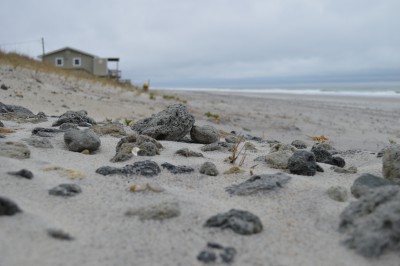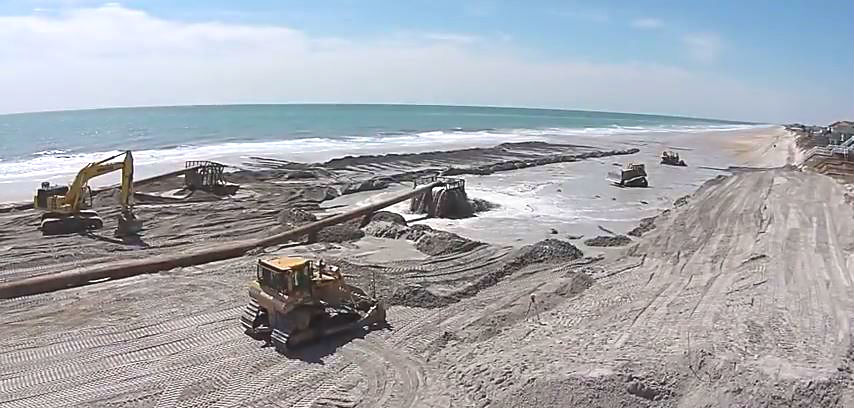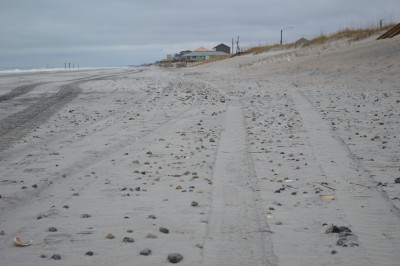NORTH TOPSAIL BEACH – Rocks on and below the surface of portions of North Topsail Beach’s ocean shoreline will have to be removed before sea turtle nesting season kicks off in May, federal and state wildlife officials say.

The U.S. Fish and Wildlife Service and the N.C. Wildlife Resources Commission notified the Army Corps of Engineers in early February that rocky material on areas of the southern end of the town’s beachfront is unsuitable for turtle nesting.
Supporter Spotlight
Those agencies, the N.C. Department of Coastal Management and the town are in discussions about how deep a contractor must dig to remove rocks inadvertently pumped onto the shore last summer during a beach renourishment project.
“Our biggest concern is getting it to three feet depth or, if they’ve lost some of the material pumped onto the beach last summer, going back to their original beach contour,” said John Ellis, a biologist with the Fish and Wildlife Service’s Raleigh field office.
Wildlife officials say heavy concentrations of rocks, atop and well beneath portions of sandy surface above high-tide line, could adversely affect sea turtle nesting. Topsail Island’s 26-mile-long beach is federally designated critical habitat for the threatened loggerhead sea turtle.
A question the town will have to answer, Ellis said, is how much of the original fill material remains on the beach. If, for example, one foot of fill has eroded away, then the town may not have to dig as deep as three feet.
Federal and state agencies will meet with town officials Tuesday, Ellis said.
Supporter Spotlight
Sea turtle nesting season begins May 1. Female sea turtles create their nests as deep as three feet to lay their eggs. Rocks buried to that depth could interfere with nest building and potentially trap hatchlings trying to dig to the surface and get to the ocean.
Having a nesting-ready beach for sea turtles is important to North Topsail Beach, said Stuart Turille, the town manager.
“We’re trying to be in complete compliance with Fish and Wildlife for rock remediation for protecting sea turtles and other wildlife,” he said. “We think this is surficial rock. That’s part of the discussion. We’re not taking a position adversarial to Fish and Wildlife. We have some data we need to clarify as to the rock further down.”
Winter storms have churned up rocks up and down North Topsail’s ocean shore, including the town’s northern end, Turille said.
“We need to clarify, is this an island-wide phenomenon or is this just in phase five?” he said. “The town is ready to remove the surface rock. I’m ready to comply, I just need to know what the parameters are.”
As far as the Fish and Wildlife Service is concerned, Ellis said, the focus of concern is within the project area.

Tons of rock were removed from the beach throughout a majority of the town’s “phase five” beach renourishment project last year. The rocks were initially uncovered by winter storms in late January and early February 2015, about two months after a dredge began pumping sand from a site along the ocean floor onto the town’s southernmost beach.
Onslow Bay has an abundance of rock bottom, but project engineers said samples from and surveys of the offshore site did not indicate a concentrated amount of rock.
The “rocks everyone vilifies,” Turille said, include fossils that are millions of years old. Their presence on shore is generating interest from paleontologists and the Smithsonian Institution.
These fossils and other rocky material pumped onto the town’s beach do not meet the state’s sand standard for beach renourishment projects. Those guidelines limit the amount of rocks over a specific size that can be pumped into the state’s beaches, but federal and state regulatory agencies allowed the project to continue as long as the town took precautions. The measures included placing rock boxes on the dredge to prevent rocks from making it onto the shore and manually picking up rocks of various sizes from the beach to a depth of 36 inches.
The nearly $17 million project was completed June 30.
Fish and Wildlife Service officials inspected the southern end of North Topsail’s ocean shoreline in mid-October and found “large amounts” of rocks in some places. Most of the rock “is smaller material that was not effectively removed by the rock boxes and rock-pickers during the beach nourishment project,” according to a Feb. 2 letter the Fish and Wildlife Service sent to the Corps.
A DCM official made similar observations in early January.
In late January, the town’s response to the state Wildlife Resources Commission was that the town did not believe large amounts of rock were on the beach, according to a Feb. 4 letter the commission sent to the Corps.

“They concluded that the rock must have been covered since the October site visit and that no remediation needed to be done,” except in one area, according to the commission’s letter.
The letter goes on to state that the agency supports the Fish and Wildlife Service’s recommendation to remove the rocks as deep as 36 inches.
DCM spokesperson Michele Walker wrote in a statement that the regulatory agency is “continuing to communicate with the town, the Corps and other resource agencies to ensure that the beach is restored to an acceptable condition with respect to sediment compatibility.”
The agency is monitoring the situation, she wrote in an email.
If the Fish and Wildlife Service maintains its position that the town must dig down to 36 inches, the Corps will hold a meeting with the town and agencies, said Mickey Sugg, project manager in the Corps’ Wilmington district.
He said that any type of rock removal would have to be done before May 1.







